Some call it hubris. Or rebellion against deep-rooted traditions. One thing is for sure, Michael Jackson rebelled against church and religion. And not only on his DANGEROUS album cover from 1991 turned Michael Jackson church traditions upside down. Maybe that was literally DANGEROUS.
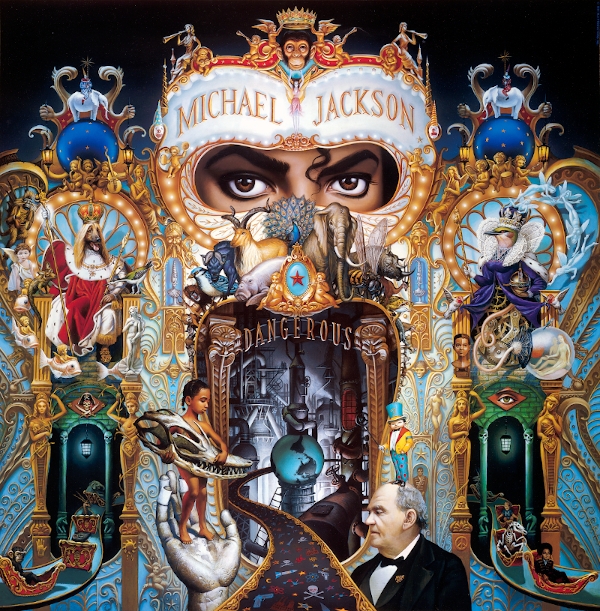
picture: Michael Jackson’s DANGEROUS album cover from 1991, SONY Music Entertainment. Painter of the painting named „King of Pop“ (acrylic on wood 82” x 74”) is Mark Ryden. The original painting is exhibited in Paul Kasmin Gallery, 293 Tenth Ave., New York, NY 10001. source
„I don`t consider myself religious in the sense of subscribing to a particular dogma. I would consider myself spiritual – in that I believe there is a domain of awareness in which we can experience our universality. I read all kinds of religious literature, because I believe there is truth in all of them.“
Michael Jackson, 1992. 1
„The tradition is still there, the artwork is there, but I’m rebelling against „the system“ in my own way.“
Michael Lee Bush, the designer for King of Pop about the philosophy in Michael Jackson’s artwork. 2
Michael Jackson, an altarpiece for the church and Napoleon
Almost two centuries prior to Michael Jackson’s DANGEROUS cover, in 1806 the French painter Jean-Auguste-Dominique Ingres painted „Napoleon on his imperial throne“. Ingres was inspired to create the bombastic representation of the Frenchman (who crowned himself) by a work of art that was meant for the church: the „Ghent Altarpiece“ painted in the 15th century. With God, the world ruler on the throne. 3 According to Ingres painting, Napoleon took the place of God.
In 1990, Michael Jackson commissioned the painter Mark Ryden to create a painting that was to be released as the DANGEROUS album cover. Ryden based his depiction of the figure of „King MJ“ on Ingre’s model of „Napoleon I on the imperial throne„. Ryden therefore too based his depiction of Michael Jackson on the „Ghent Altarpiece“ from the 15th century, which was intended for the church. With God the judge of the world on the throne. So according to Ryden’s DANGEROUS painting, „King MJ“ not only took Napoleon’s place but God’s place too.
In 1806, the painter Ingres portrayed Napoleon on his imperial throne like an eternal regent. Given Napoleon’s deathly pallor apparently a regency well beyond death. Painter Ingres was citing Christian traditions in his painting and depicted the self-appointed emperor as if he was God himself.
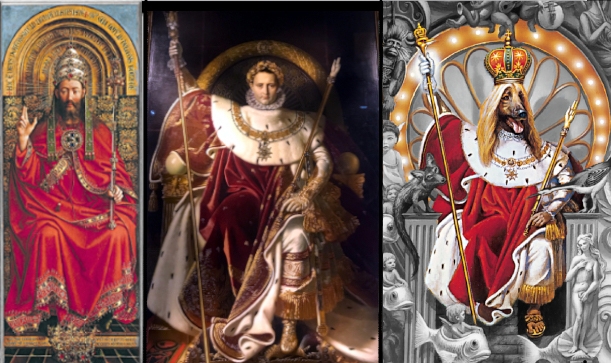
Michael Jackson, Rebellion against religion and the church or the „King of Kings“
The center and main figure on the (Ghent) Altarpiece is „God the Father“ as judge/ruler of the world. On Ingres „Napoleon“ the „Almighty“ Napoleon fills the place of God. On Mark Ryden and Michael Jacksons DANGEROUS Cover the Dog King (in which Michael Jackson „MJ“ is hidden) fills this place. If one were to apply not only the visual representation of the main character of the Ghent Altarpiece but also the literary descriptions, the result would read as follows on the DANGEROUS cover from the King of Pop in 1991:
„King MJ“, „King of Kings, and Lord of Lords“.
„King MJ“, „God the Father/the Holy Trinity amalgamated into a single person“. 4
For more information about the Ghent Altarpiece see this link: Genter Alhttps://de.wikipedia.org/wiki/Genter_Altartar.
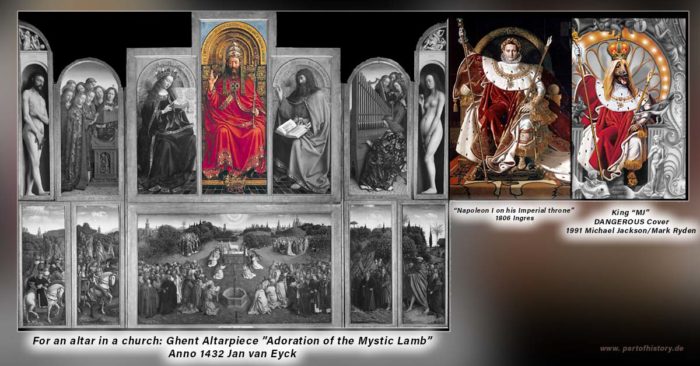
Michael Jackson proclaimed throughout his life: „Do something good and you will be close to God“ and therefore the message in his portrayal by re-arranging the Ghent Altarpiece can may be similar interpreted. However, in 1991 the church was certainly not amused by the new arrangement of its established symbols. At the same time, the church was also provoked by another Madonna and was busy keeping her „Blonde Ambitions“ under control. This went so far that Pope John Paul II called for a boycott of the concerts by Madonna (the singer) claiming Madonna with her performance had „re-released Satan into the world again“. 5, 6 Madonna and Michael Jackson by the way shared the same choreographer: Vincent Paterson. 7, 8
The church dictates art. Anno domini 1989. And Michael Jackson did not only start a rebellion against religion and the restrictions of the churches in 1991.
„Rearranging minds and thoughts“ Michael Jackson 1991 about churches und religion
In altarpieces like the Ghent Altarpiece, which had been the blueprint for Napoleon’s depiction of „Emperor Napoleon“ and the portrayal of the King of Pop, Michael Jackson, church traditions defined structure and arrangement. In altarpieces like the Ghent Altarpiece by the 15th century painter van Eyck, the „celebrations of a church service“ were portrayed. That were ceremonies, strict arrangements and traditions that had been hard fought for by the church because in a strictly established order people can be better controlled.
But in the course of history, disobedient artists have always appeared and upset these entrenched orders. Furthermore, there have always been rebellious artists whose works challenge people to think for themselves. 9
Michael Jackson in the 1990s was in the global public interest with everything he did, and he continued this rebellious tradition. Jackson quoted these old established orders, like the one from the Ghent Altarpiece, and turned the conventions upside down. And Jackson rebelled on a global level. That was DANGEROUS in 1991. That was THREATENED in 2001.
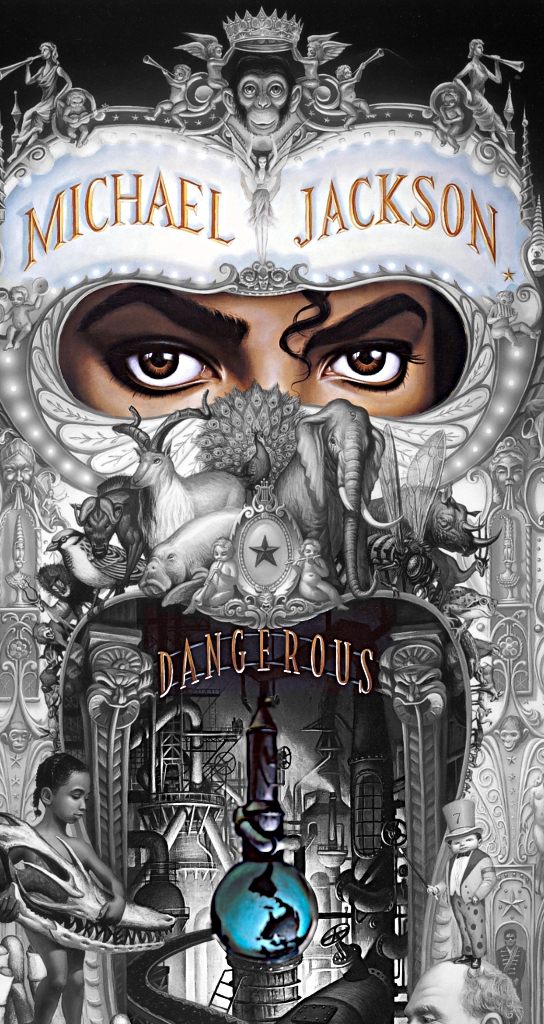
In the 1980s, Michael Jackson had his own personal experience with rebellion against religion. The church he belonged at that time began to dictate his art. As a result, Jackson felt compelled to leave his religious community of Jehovah’s Witnesses in 1988. And in 1991, Jackson sang an angry song about it:
„False prophets cry of doom/What are the possibilities?“[…] I’m Conditioned by the System … what are the possibilities?“ … Confusion contradicts the self ... The world keeps changing/Rearranging minds and thoughts“
Michael Jackson 1991 in JAM. 10
„Conditioned by the system“ is this Michael Jackson 1991 complaining about the church?
In 1988, during the shooting of SMOOTH CRIMINAL, Michael Jackson’s church of Jehovah’s Witnesses, with its strict rules, had given him an ultimatum: Jackson should choose between entertainment or the Jehovah’s Witnesses. For years, the personal „monitors“ of Jehovah’s Witnesses had monitored Jackson’s professional activities and reported back to the highest authorities of his religious community. They criticized THRILLER as occult, Jackson’s dancing style as too obscene. Complaints and subpoenas were the result for Jackson. Then, in 1988, Michael Jackson filed his resignation from the Jehovah’s Witnesses so to speak. Jackson publicly resigned from the Jehovah’s Witness in the passive-aggressive rebellious „Michael-Jackson-Way“: In 1988, in SMOOTH CRIMINAL, Jackson grabbed a machine gun and fired in rage. But the use of a gun in the film contradicted the statutes of Jehovah’s Witnesses. After more than twenty years of belonging to this religious community, Jackson must have been familiar with these rules. The Witnesses then gave him an ultimatum: he had to leave the entertainment industry or the Jehovah’s Witnesses.
„They ordered that I have to make decision. I must leave the church, or leave the entertainment industry.“
Karen Faye, 2010, longtime make-up-artist for Michael Jackson. 11
We know about his decision. Somehow Michael Jackson left Jehovah’s Witness no choice: every shot from the SMOOTH CRIMINAL’s machine gun sealed his disfellowship without giving notice.
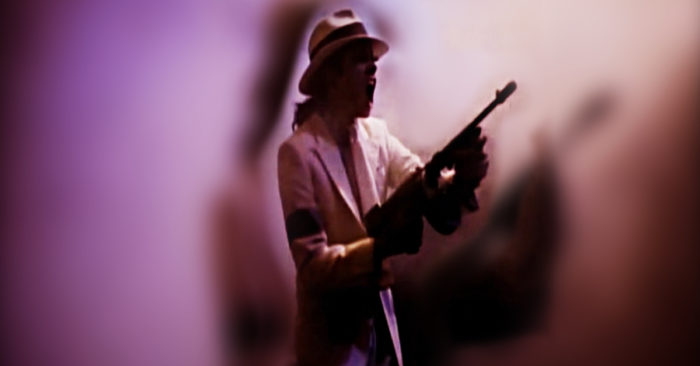
Picture: Is the SMOOTH CRIMINAL Michael Jackson shooting his way out in 1988? source
„You Can′t Hurt Me I Found Peace Within Myself“
Michael Jackson 1991 in JAM, Song number 1 on DANGEROUS
But back to Michael Jackson, the Ghent Altarpiece and the DANGEROUS „Altarpiece“ by the King of Pop from 1991. And a potential rebellion from Michael Jackson against religion.
Michael Jackson, rebellion against religion because he knew what he was doing: „Three great figures“ and a „world judge“?
The Ghent Altarpiece portrays „three great figures“ as the main characters: Virgin Mary and God the Father/Judge and John the Baptist. In 1991, the female figure Mary might have made it onto Jacksons album cover DANGEROUS. Just like on the Ghent Altarpiece, you can see on Jacksons DANGEROUS „three great figures“. With this approach however, on DANGEROUS the position of God, the ruler of the world, would be taken by the one with the name in the halo:
MICHAEL JACKSON
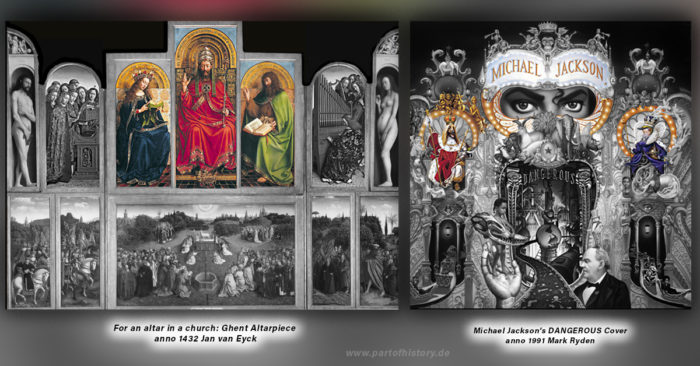
… to worship the one in the middle
Michael Jacksons album cover DANGEROUS from 1991 borrows even more from the altarpiece than just three figures:
It seems in 1991 the groups of figures gathering in the same form.
And also the form of the group of people in Ghent is amazingly similar to the form of the children in the fishes around the Dog King on DANGEROUS.
Does the shape of the „sinners“ from Ghent in the gondolas also reappear on the record cover?
Four groups of people, in the original Ghent Altarpiece named „Martyrs who were clerics“, „Holy Virgins“, „Patriarchs“ and „Shepherds of the Church“ 12, skip 500 years and come together in their pure form on DANGEROUS in Jackson’s Ghost Train. They all gather around the „Fountain of Life“.
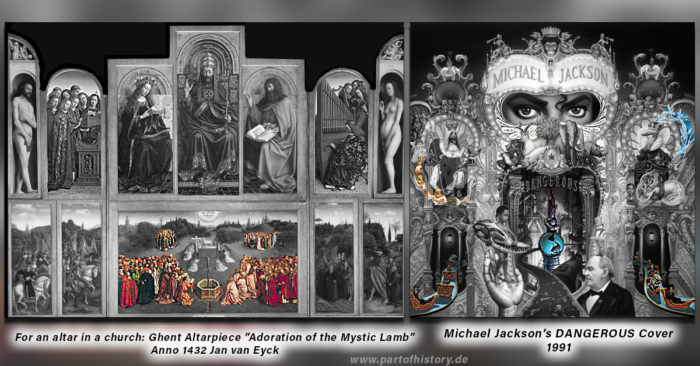
Michael Jackson, the DANGEROUS Cover and „The fountain of life“
The “fountain of Life“ is the fountain on the Ghent Altarpiece by van Eyck. The fountain of Life would then be the earth by Mark Ryden and Michael Jackson.

Vertical Axis on the Ghent Altarpiece and Michael Jacksons DANGEROUS
„A vertical axis forms between the fountain, the altar, and the dove signifying the agreeing testimony of The Spirit, the water, and the blood.“ source: Wikipedia. Can both paintings, the Ghent Altarpiece and Jacksons Dangerous, be read from top to bottom?

Michael Jackson and religion: the holy ghost, love. And a peacock.
Five hundred years prior to Michael Jackson DANGEROUS cover, the dove found its place on the Ghent Altarpiece in the sky in golden sunrays. The dove is a symbol of the Holy Spirit and peace. In 1991, the peacock appears in Michael Jackson’s work in the same place and is also surrounded by golden rays.
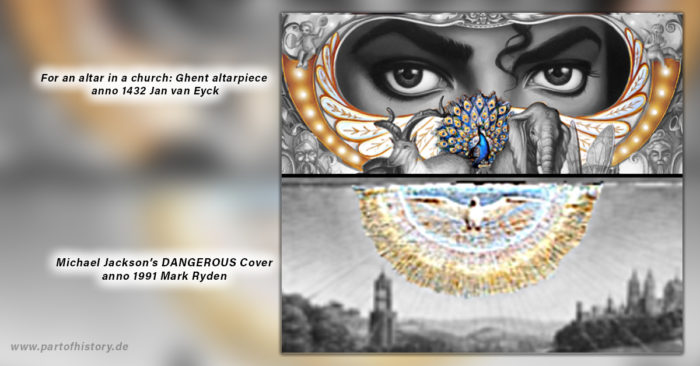
They say, among all great leaders the light is a symbol of truth and the divine. This was already known to the French Sun King Louis XIV. Michael Jackson was inspired by the symbols of the Sun King in his career, as shown here in the video on YouTube. „Michael Jackson: The Moonwalker and The Sun. A King to represent a Great Leader“.
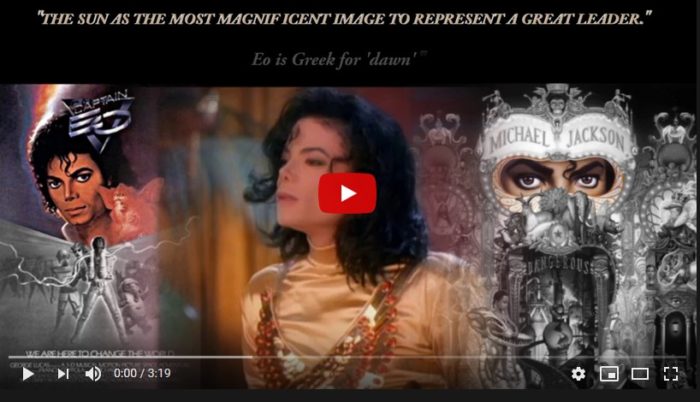
You can klick on this Link to watch the Video on YouTube:
„Michael Jackson: The Moonwalker and The Sun. A King to represent a Great Leader“.
The dove is a symbol of peace, love and the „Holy Spirit“.
The peacock is a symbol of love, harmony and „Michael Jackson“.
The peacock has been inseparably connected to Michael Jackson, the performer, since 1978:
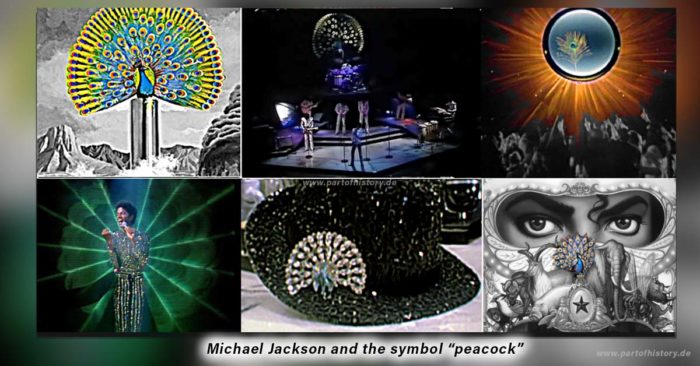
This is also the case in the Vatican in Rome. The dove, of course.
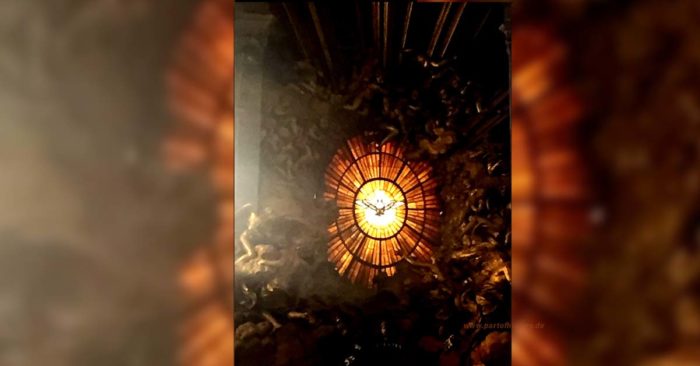
picture: Light around the dove in the St. Peter’s Basilica, Rome. Foto by author
Michael Jackson and the crown of creation
The open crown at the feet of the ruler of the world – the one on the Ghent Altarpiece – has moved upwards on the album cover from the King of Pop centuries later. Bubbles, Michael’s chimpanzee, provides the perfect setting.

„It’s hard to see angels …“ Michael Jackson, 1991
In 1432, two-winged angels wave incense on the altarpiece from Ghent. In 1991, on Michael Jackson’s DANGEROUS cover, the shape, formed by these angels, reappears. In the birds under the queen.
„It’s hard to see angels, although I’ve stared at their pictures for hours. Some people can see them without pictures, and they tell interesting tales.“
Michael Jackson, 1991. 13
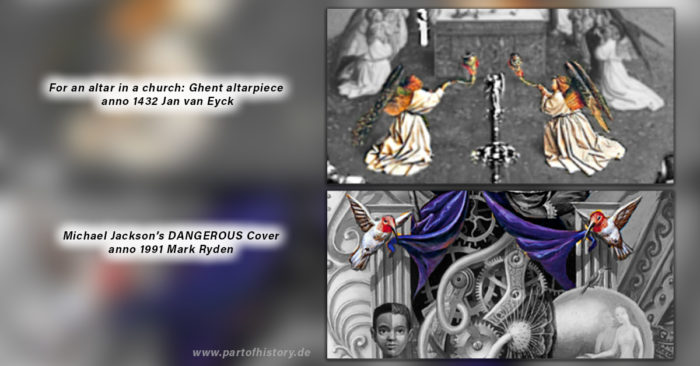
In the original Altarpiece angels adore the lamb, the symbol for the Christian church, glorified innocence and symbol of the self-sacrifice of Jesus. The lamb on the sarcophagus in the Ghent altarpiece is symbolic for the dead Jesus. Is there a connection on DANGEROUS to the deadly-like Bird-Queen who rules the Kingdom of EXITUS? The Bird-Queen, who is somehow connected to the Moon and the Moonwalker?
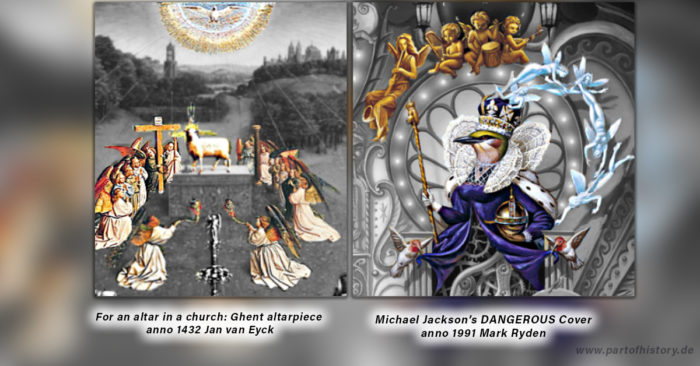
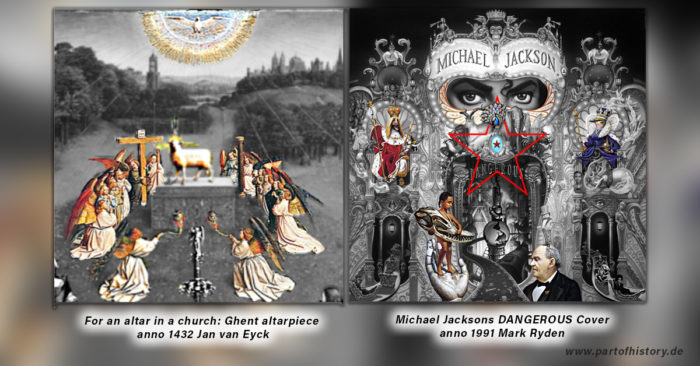
A hint of Adam and Eve on Dangerous?
And perhaps Adam and Eve from the altarpiece in 1432 will also find their way into the amniotic sac of the queen bird in the moonlight of 1991.
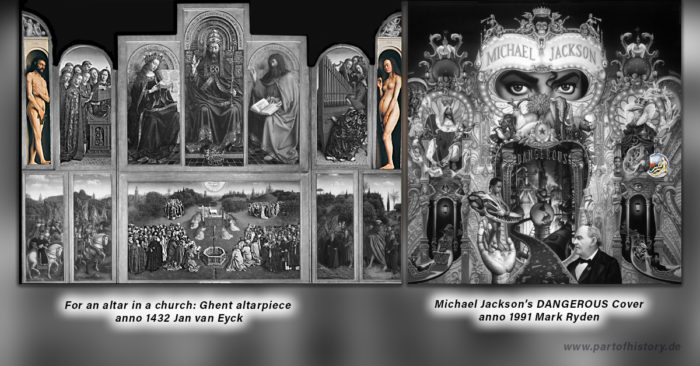
Even though the amniotic sac from the DANGEROUS cover is more than similar to that of Hieronymus Bosch from the „Garden of Earthly Delights„. It seems, they tell the same story.

l.: Amniotic sac in Hieronymus Bosch’s painting „Garden of Delights“
r: Michael Jackson’s DANGEROUS album cover, 1991. Painter Mark Ryden.
„The moon rules over conception, pregnancy and birth […] over every kind of creation.“
The book of symbols 14
500 years between two mirrors on Michael Jacksons DANGEROUS and the Ghent Altarpiece
In comparison with the original „God the Father“ on the Ghent Altarpiece, an intentional re-arrangement of forms results in a togetherness that connects 500 years:
The lower part of the altarpiece (the one from Ghent in 1432) looks like a mirror image of the upper one. If one brings together the distance between heaven and earth and overcomes it, the separated parts merge into one. They literally COME TOGETHER.

The question remains: Is the portrayal of Michael Jackson in 1991 on DANGEROUS hubris or rebellion against religion? Or an expression of Michael Jackson’s gratitude for his God-given talents?
„Michael [hebrew ’One Who Is Like God‘]. Michael, God’s defender.“
15
Related articles:
Quellen
- Jackson, Michael, Out Of The Mouth Of Michael von Paskin, Glenn. 1992.08.16., Chicago Tribune, articles.chicagotribune.com/1992-08-16/entertainment/9203140099_1_dreams-spirituality-daily-journal
- Bush, Michael Lee, Michael Jackson-King of Style – Dressing Michael Jackson, Bush, Michael Lee. 2012/2013, Inside Edition/San Rafael, California, page 9, 136,
- Graham-Dixon, Andrew, ITP 240: Napoleon I on His Imperial Throne by Jean-Auguste-Dominique Ingres , 05.12.2004; accessed on 17.08.2015, „It is a bizarre fantasy but one that perfectly reflects that illusion of inviolability and infallibility, with dangerous megalomania, that was eventually to be Napoleon’s downfall.“, andrewgrahamdixon.com/archive/itp-240-napoleon-i-on-his-imperial-throne-by-jean-auguste-dominique-ingres.html
- Dupuis-Panther, Ferdinand, Jan van Eyck und das Geheimnis des Lamm Gottes, https://www.schwarzaufweiss.de/belgien/janvaneyck.htm
- Madge through the years, accessed on 09.04.2015, „[…] 1987: Controversy heats up as her Who’s That Girl? tour makes a stop in Turin, Italy. The pope urges people to skip her shows./1989: „[…]
- Vincent Paterson – The man behind the throne, 2013, Madonnas choreographer Vincent Paterson explained: „My most favorite review I ever got was from the pope. When the „Blonde Ambition“-Tour played in Rome. Their headlines of the newspaper said: „With the blonde Ambition tour satan has been re-released into the world.“ I said: „Oh my god, I did THAT?!“
- https://www.vincentpaterson.com/www.vincentpaterson.com/DOCUMENTARY.html
- Tomassan, Robert E., Chronicle, accessed on 12.04.2016,
- de Tolnay, Charles, Hieronymus Bosch. Das Gesamtwerk 1984: „Towards 1475, at a time when the artistic career of Hieronymus Bosch was beginning, the masters of Bruges, Ghent, Louvain, Haarlem and Delft were painting according to the old principles established at the beginning of the century by the master of Glemalle and Jan van Eyck. The paintings of these masters were filled with the solemnity of worship and thus inspired the believer to humble devotion and mystical elevation of the soul. This means that the viewer is elevated to a higher sphere, where, however, the language of feelings is conventional and does not find words to lead him to self-knowledge and conscious experience of the real world. Hieronymus Bosch was the first to break this noble convention; his paintings address the mind directly and help the viewer to form an independent judgment about man and the reality of things. With him, art leaves th paternalism of the Church.“, HASSO EBELING International Publishing Munich GmbH; Rheingauer Verlagsgesellschaft RVG, Eltville; Copyright 1965 by HOLLE Verlag Baden Baden, page 10
- Jackson, Michael, JAM, 1991.11.26., DANGEROUS – Album, EPIC Records
- Faye, Karen, karenfayeblog.com/2010/08/29/august-29th/
- https://de.wikipedia.org/wiki/Genter_Altar, Wikipedia picture: „Retable de l’Agneau mystique“ by Jan van Eyck (around 1390–1441) licensed under public domain via Wikimedia Commons – https://commons.wikimedia.org/wiki/File:Retable_de_l%27Agneau_mystique.jpg#/media/File:Retable_de_l%27Agneau_mystique.jpg, abgerufen am 17.08.2015, https://de.wikipedia.org/wiki/Genter_Altar
- Jackson, Michael, Dancing the Dream – Angel of Light, 1992/1993, Doubleday an imprint of Transworld Publishers, London/Goldmann Verlag Bertelsmann.
- Ami Ronnberg, Kathleen Martin, The Archive For Research In Archetypal Symbolism, Das Buch der Symbole – Betrachtungen Zu Archetypischen Bildern, 2010, Taschen Verlag, Cologne, page 26
- Der Neue Brockhaus, Allbuch in vier Bänden und einem Atlas; L-R, F. U. Brockhaus/Leipzig, page 1937